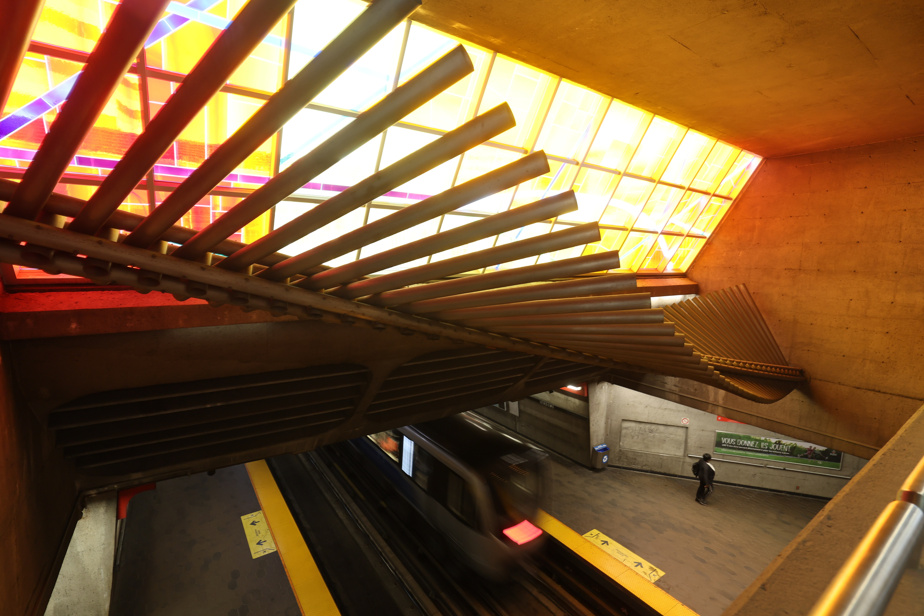Discover other works not to be missed in the metro
Originally
Eager to rethink human relationships in the city and bring some cheerfulness to this rather monochrome urban space, Marcelle Ferron swapped abstract painting for large public works, clearly visible to all, mainly to users of the Montreal metro. Her installation Canopy (1968), which immerses the Champ-de-Mars station in colored light beaches, is undoubtedly the most effective in this regard.
His artistic vision aligned with that of the mayor at the time, Jean Drapeau, and his advisors, including Lucien Saulnier, regarding the design of the metro: to humanize and make this transition space between “work and sleep” attractive to users. From the creation of the first stations around the 1970s, an artist was invited to work with an architect to create an original work. Thus, each station was designed in a unique way and developed its own identity. Succeeding in this mission was a feat of strength: “Each station has its constraints: taking into account the toponymy, the public, the ground. Some are built by excavation, others by drilling…”, explains Université de Montréal professor Louise Vigneault.

PHOTO JEAN-YVES LÉTOURNEAU, LA PRESSE ARCHIVES
Marcelle Ferron
The program initially commissioned figurative frescoes on the history of Montreal under the direction of artistic director Robert LaPalme, but abstract works quickly made their way into the spaces. This introduction of contemporary art into the metro was made possible by the work of Jean-Paul Mousseau, who took up the torch after LaPalme’s departure. Like Marcelle Ferron, Jean-Paul Mousseau, also an artist and signatory of Global refusalparticipated in creating the first abstract works of the initial network.
The work

PHOTO PATRICK SANFAÇON, LA PRESSE ARCHIVES
There Canopy by Marcelle Ferron is located at the Champ-de-Mars station. Unfortunately, it is not currently accessible to the public.
There Canopy by Marcelle Ferron is one of these pioneering achievements. In addition to raising awareness of contemporary art among the uninitiated and making it accessible to all, it still fulfills the initial mandate of humanizing the metro to this day: thanks to its colors and the reflection of the glass on the walls, on the floor and even on people, the work restores happiness to metro users. It is a shame that, for the commemorations of the 100e artist’s birthday, the Canopy is not accessible given that the major construction site of Place des Montréalaises covers it.
Consult the STM information page on the work Canopyby Marcelle Ferron
Art and architecture to feel good in the metro
-

PHOTO MARTIN CHAMBERLAND, THE PRESS
Jean-Paul Mousseau, Circles1966, ceramic. Located in Peel station.
-

PHOTO MARTIN CHAMBERLAND, THE PRESS
Gabriel Bastien and Andrea Vau, Mosaic1969, Venetian marble. Located on the platform of Côte-Vertu station.
-

PHOTO MARTIN CHAMBERLAND, THE PRESS
LaSalle metro station
1/3
The initial ambitions of Marcelle Ferron and Jean Drapeau were monumental and dealt with the reality of the metro: “It’s not easy to be in the metro when you think that 10% of people are claustrophobic. It’s a psychological challenge: we’re below ground,” recalls Louise Vigneault.
So why do we still feel good there? It’s thanks to art and architecture. “Architects and artists had the same challenges: that people feel safe and that they can easily find their way around the metro,” according to Louise Vigneault, who confirms that “artists had their role to play in this humanization.”
Compared to some subways like those in Paris or New York, where you travel along long, narrow and potentially anxiety-provoking corridors, several stations in Montreal are large open spaces, with suspended walkways, for example. “You can see everything, it’s easy to breathe, you’re safe,” says the art historian, who gives the example of the Lionel-Groulx station, created by architect Yves Roy, originally from Gaspésie and, therefore, a citizen who is certainly used to dealing with large spaces.
And today, advertising rubs shoulders with art
-

PHOTO MARTIN CHAMBERLAND, THE PRESS
Advertisements in the Montreal metro, Place-des-Arts station
-

PHOTO MARTIN CHAMBERLAND, THE PRESS
At the Peel metro station, an advertisement for a mobile and internet provider sits alongside a work by Jean-Paul Mousseau.
1/2
On the eve of the construction of the extension of the blue line, where budgets are limited, where users are increasingly teleworking, where those who use the metro look more at the screen of their phone than at the spaces in which they walk, what artistic choices are we making for the metro?
Currently, the works share space with advertisements. At the time of the conception of the Canopyno advertising image rivaled the creations. These images appeared in Montreal’s undergrounds in the early 1990s, at a time when the provincial government was reducing its participation in funding the Société de transport. “It’s a choice to put advertising in a place. It’s a societal choice that we make,” says Louise Vigneault.
But everything suggests that there is hope that the humanization of the metro will continue during the construction of the next stations and that, perhaps, Marcelle Ferron’s wishes will continue to be fulfilled. A plan to integrate works of art into the architecture is being put together. What’s more, the names of the five artists chosen for this major project are known – Ludovic Boney (Pie-IX station), Jocelyne Alloucherie (Viau station), Alain Paiement (Lacordaire station), Marc Séguin (Langelier station), Nadia Myre (Anjou station) – and they should work quite closely with the station’s architect-designer. At least, that’s what the Société de transport de Montréal (STM) is promising its users… and art lovers.
